Gimme a Beef Bowl and Eat Bok Choy
Our Mongolian Beef recipe became ane of the most popular Woks of Life recipes afterward we first published information technology in July 2015, and for good reason!
The Origins of Mongolian Beef
Only first. What exactly are the origins of Mongolian Beefiness? Because it's definitely non Mongolian…
In fact, in Mongolia, generally, domicile cooks simply boil meat and dip information technology in sauces. Not exactly a stir-fry.
Everything is served with Bai Jiu, a stiff, white lightning liquor made of sorghum (normally 90 proof or higher!) very popular in Communist china.
(A friend of mine who visits his Mongolian in-laws most always ends up drunk and horizontal on the couch subsequently the traditional welcome-dwelling dinner!)
As for the true origins of Mongolian beefiness, my theory is that someone merely forgot to add the orange to a wok full of Orangish Beef, and added more carbohydrate instead. Hence, the Mongolian Beef recipe was born. (But, as Judy and the girls would say, that's simply my crazy theory/the ramblings of an erstwhile coot!)
Anyway, chalk it upwardly to Chinese-American carte du jour planners and marketers who dubbed the dish "Mongolian Beef."
It's a shut cousin to "Singapore Noodles," a dish that many actual Singaporeans scratch their heads over––most probable born in the stainless steel kitchen of a Chinese takeout articulation!
The Woks of Life Mongolian Beef Recipe
At present that we have that clear, information technology doesn't take a genius to know that despite their somewhat misleading names, these Westernized Asian dishes can be Proficient!
P.F. Chang's version of this dish is probably the most well-known, but, personally, I call back their dish is way too sweet, and information technology's definitely too sweet for Judy (which is saying something, since she comes from Shanghai, where sweet-savory dishes are oft the main issue).
In fact, when Judy institute out I was going to brand a Mongolian beef recipe, the exclamations were strong and immediate: "Too sweetness! Too oily! No good! Y'all're crazy!"
So, I adjusted.
- Cut the sugar–wayyy downward.
- Reduce the corporeality of oil used–wayyy downwards.
And afterwards the photographs were taken, the Mongolian beef on the plate disappeared before all of our eyes once the rice was served. Amidst the feeding frenzy were these comments, muffled by mouthfuls:
- Sarah: "Holy crap, that'southward tasty!"
- Kaitlin: "Daaang, gimme more than of that rice!"
- Judy: "WOW. That is SO good!"
- My humble remark: "Ok, you guys were hungry."
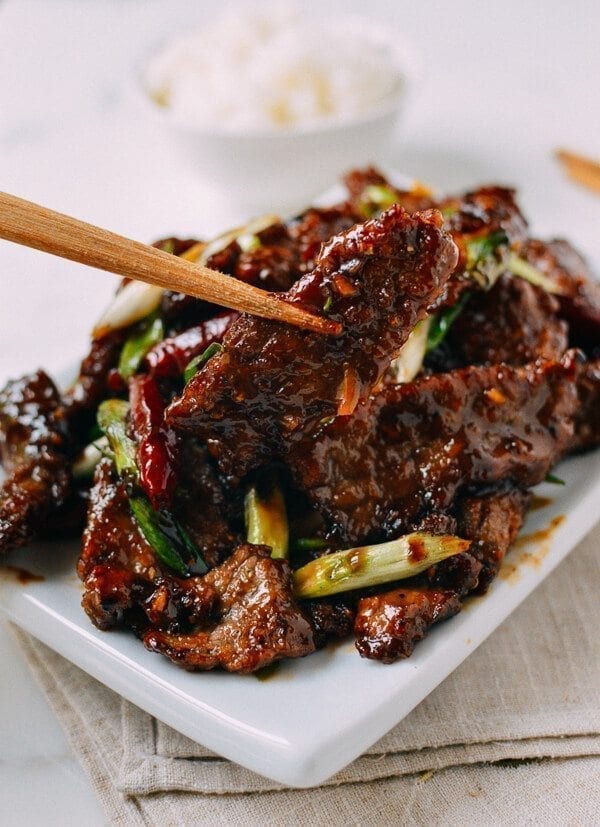
If you would rather accept some craven, and so check out our popular Mongolian Chicken recipe!
Mongolian Beef Recipe: Instructions
Combine the sliced beef with i teaspoon oil, 1 teaspoon soy sauce, and 1 tablespoon cornstarch and let it sit down and marinate for an hour. The beef should still be quite moist after information technology has marinated. If it looks too dry, add together a tablespoon of water to it.
Next, dredge the marinated beef slices in the remaining 1/4 cup of cornstarch until lightly coated. These steps ensure that the Mongolian Beef is tasty and crispy! For more detailed data on the many means to use cornstarch to get authentic results at dwelling with our recipes, encounter our post on How to Use Cornstarch in Chinese Cooking.
In a pocket-sized bowl, mix dark-brown sugar and hot water (or depression sodium chicken or beef stock) until the saccharide is dissolved. Mix in 1/4 cup low sodium soy sauce.
If you don't have depression sodium soy sauce, substitute 2 1/2 tablespoons regular soy sauce and one ane/2 tablespoons water. The saltiness of various soy sauce brands varies, and so give the sauce a taste, and suit the amounts of sugar/soy sauce/water/stock to your own gustation.
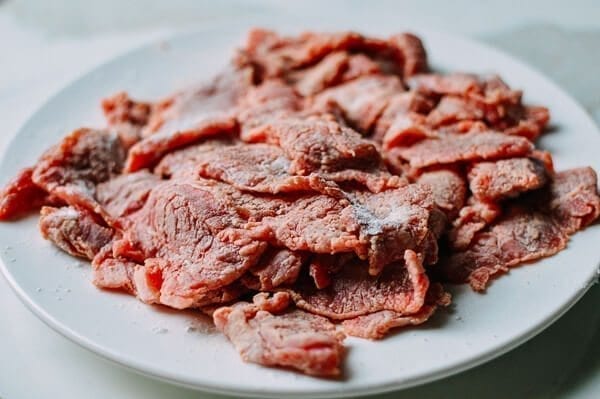
Heat 1/3 cup oil in the wok over loftier heat. Just before the oil starts to smoke, spread the flank steak pieces evenly in the wok, and let sear for 1 infinitesimal (depending upon the oestrus of your wok). Fry in smaller batches for best results! Turn over and let the other side sear for another thirty seconds.
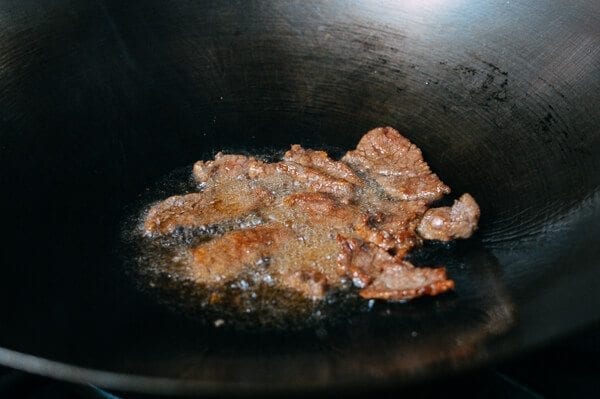
Remove to a sail pan; tilt information technology slightly to let the oil drain to i side (lean information technology on a cookbook or cutting board). The beefiness should be seared with a crusty coating.
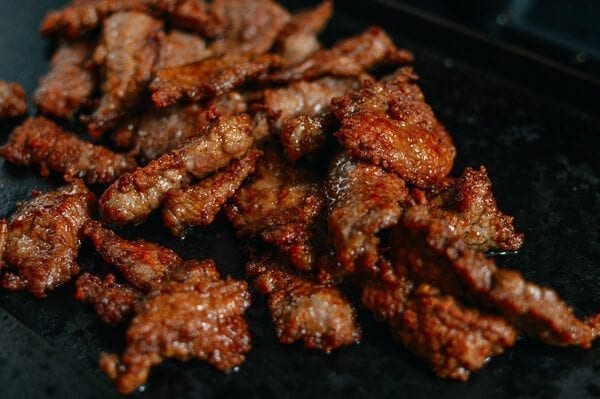
Drain the oil from the wok, leaving 1 tablespoon behind, and turn the heat to medium-high. Add together the ginger and dried chili peppers, if using.
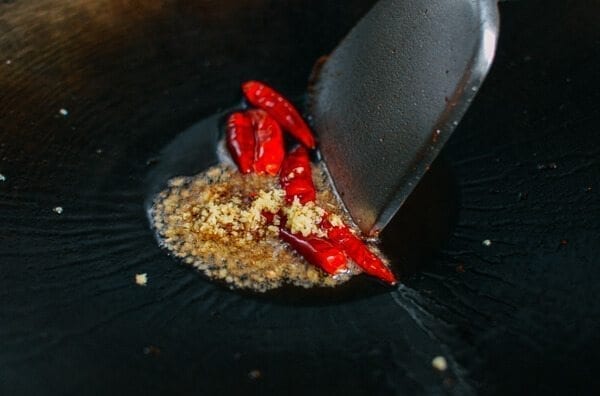
After about 15 seconds, add together the garlic. Stir for another 10 seconds and add the premixed sauce.
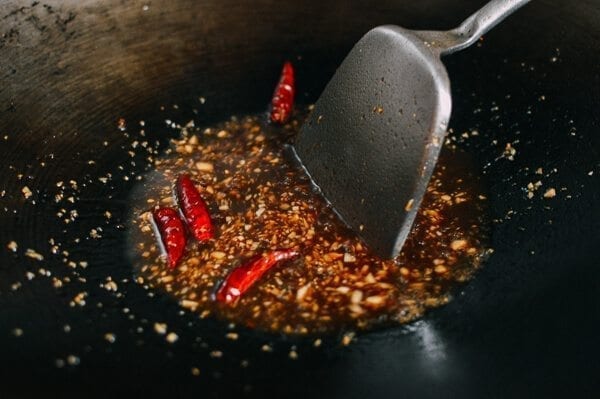
Let the sauce simmer for almost 2 minutes. Then slowly stir in the cornstarch slurry (1 tablespoon cornstarch mixed with 1 tablespoon water) mixture. Simmer until the sauce is thick enough to glaze the back of a spoon.
Add the beef and scallions, and toss everything for another 30 seconds.

There should exist about no liquid as the sauce should be clinging to the beef. If you nonetheless have sauce, increment the estrus slightly and stir until thickened.
Plate and serve with hot steamed rice!
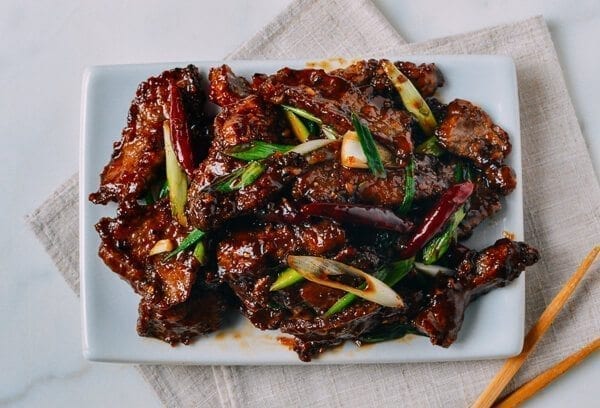

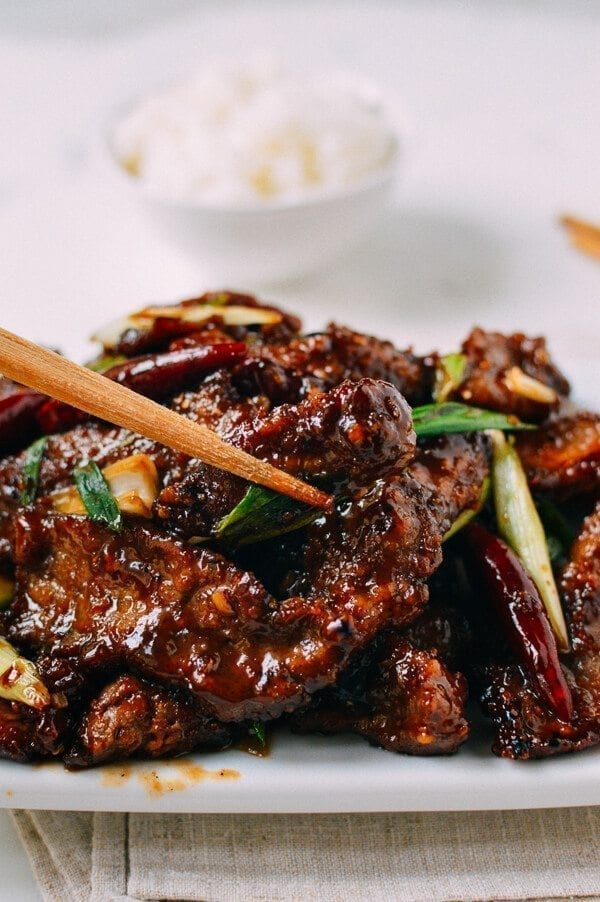
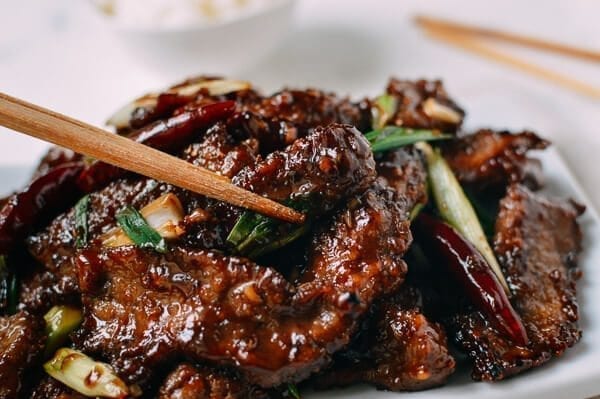
Prep: ane hr 15 minutes
Cook: ten minutes
Total: 1 hour 25 minutes
- 8 ounces flank steak (225g, sliced against the grain into 1/4-inch thick slices)
- ane teaspoon vegetable oil (plus i/iii loving cup for frying)
- 1 teaspoon soy sauce
- 1 tablespoon cornstarch (plus one/four cup, divided)
- two tablespoons brown saccharide
- ane/4 cup hot water (or hot low sodium chicken or beef stock)
- 1/iv cup low sodium soy sauce or 1 1/ii tablespoons water and two 1/2 tablespoons regular soy sauce
- ane/two teaspoon ginger (minced)
- 5 stale red chili peppers (optional)
- ii cloves garlic (chopped)
- 1 tablespoon cornstarch (mixed with 1 tablespoon water to make a slurry)
- 2 scallions (cutting into 1-inch long slices on the diagonal)
-
Combine the sliced beef with one teaspoon oil, one teaspoon soy sauce, and 1 tablespoon cornstarch. Marinate for one hr. The beefiness should still be quite moist afterward it has marinated. If it looks as well dry out, add a tablespoon of h2o to it.
-
Next, dredge the marinated beefiness slices in the remaining i/4 cup of cornstarch until lightly coated.
-
In a small-scale bowl, mix brown sugar and hot water (or low sodium chicken or beef stock) until the sugar is dissolved. Mix in 1/4 cup low sodium soy sauce. If you don't have low sodium soy sauce, substitute 2 i/2 tablespoons regular soy sauce and 1 1/2 tablespoons h2o. The saltiness of diverse soy sauce brands varies, so give the sauce a taste, and adjust the amounts of carbohydrate/soy sauce/water/stock to your ain taste.
-
Heat one/three cup vegetable oil in the wok over high heat. Only earlier the oil starts to smoke, spread the flank steak pieces evenly in the wok, and sear for 1 minute (depending upon the heat of your wok). Plow over and let the other side sear for another xxx seconds. Remove to a sheet pan. Tilt it slightly to let the oil drain to i side (lean it on a cookbook or cutting board). The beef should exist seared with a crusty coating.
-
Drain the oil from the wok, leaving 1 tablespoon behind, and turn the heat to medium-high. Add the ginger and dried chili peppers, if using. Afterward about 15 seconds, add the garlic. Stir for another 10 seconds and add the premixed sauce.
-
Permit the sauce simmer for near 2 minutes and slowly stir in the cornstarch slurry mixture. Cook until the sauce has thickened enough to glaze the back of a spoon.
-
Add the beef and scallions and toss everything together for another 30 seconds. In that location should be almost no liquid, every bit the sauce should be clinging to the beef. If you still have sauce, increase the heat slightly and stir until thickened. Plate and serve with steamed rice!
Calories: 375 kcal (19%) Carbohydrates: 17 g (6%) Poly peptide: 18 one thousand (36%) Fat: 27 m (42%) Saturated Fat: 19 g (95%) Cholesterol: 45 mg (fifteen%) Sodium: 810 mg (34%) Potassium: 334 mg (x%) Cobweb: i thou (four%) Sugar: nine g (ten%) Vitamin A: 300 IU (6%) Vitamin C: 2.one mg (iii%) Calcium: 36 mg (4%) Iron: one.vii mg (9%)
Source: https://thewoksoflife.com/mongolian-beef-recipe/
0 Response to "Gimme a Beef Bowl and Eat Bok Choy"
Post a Comment